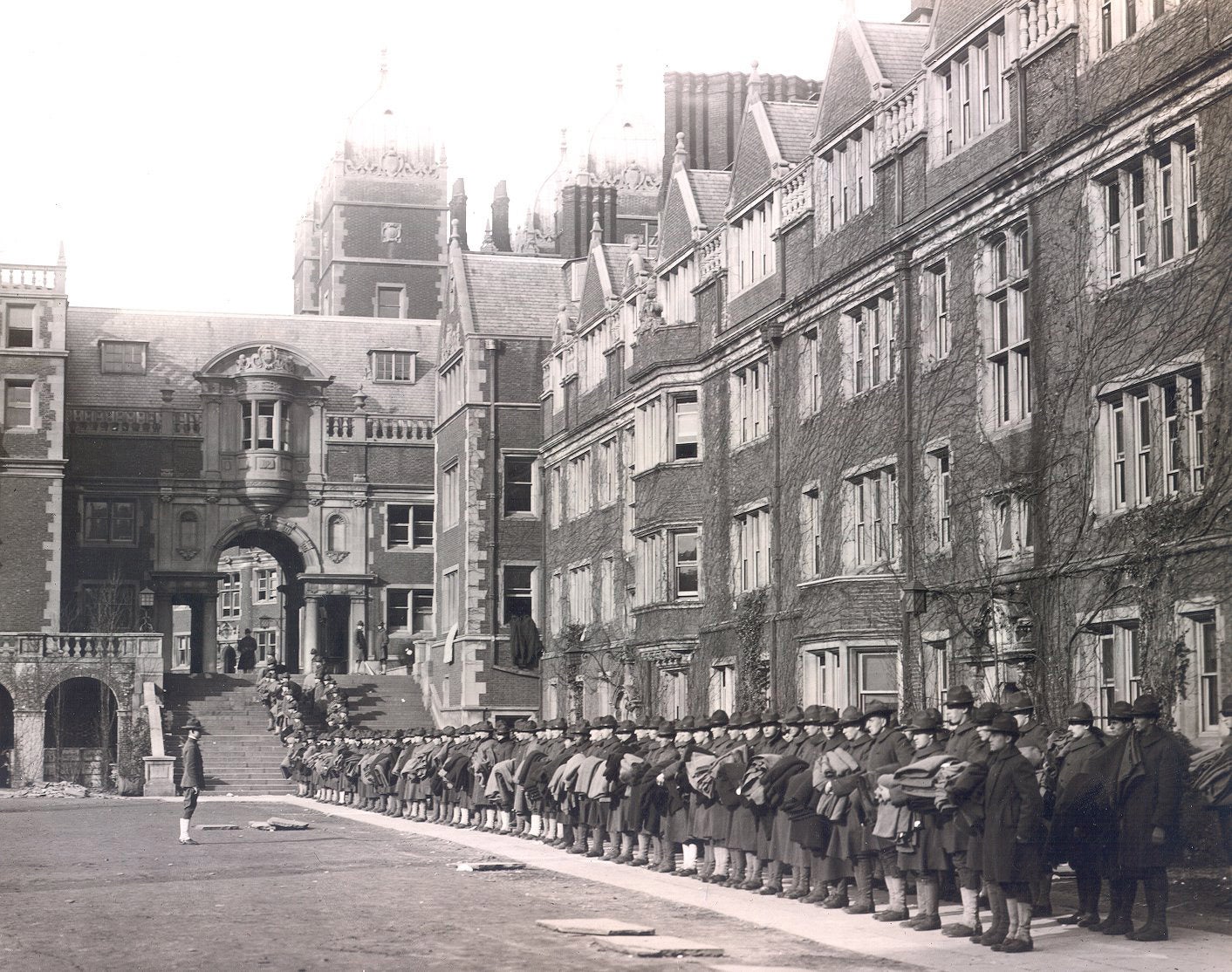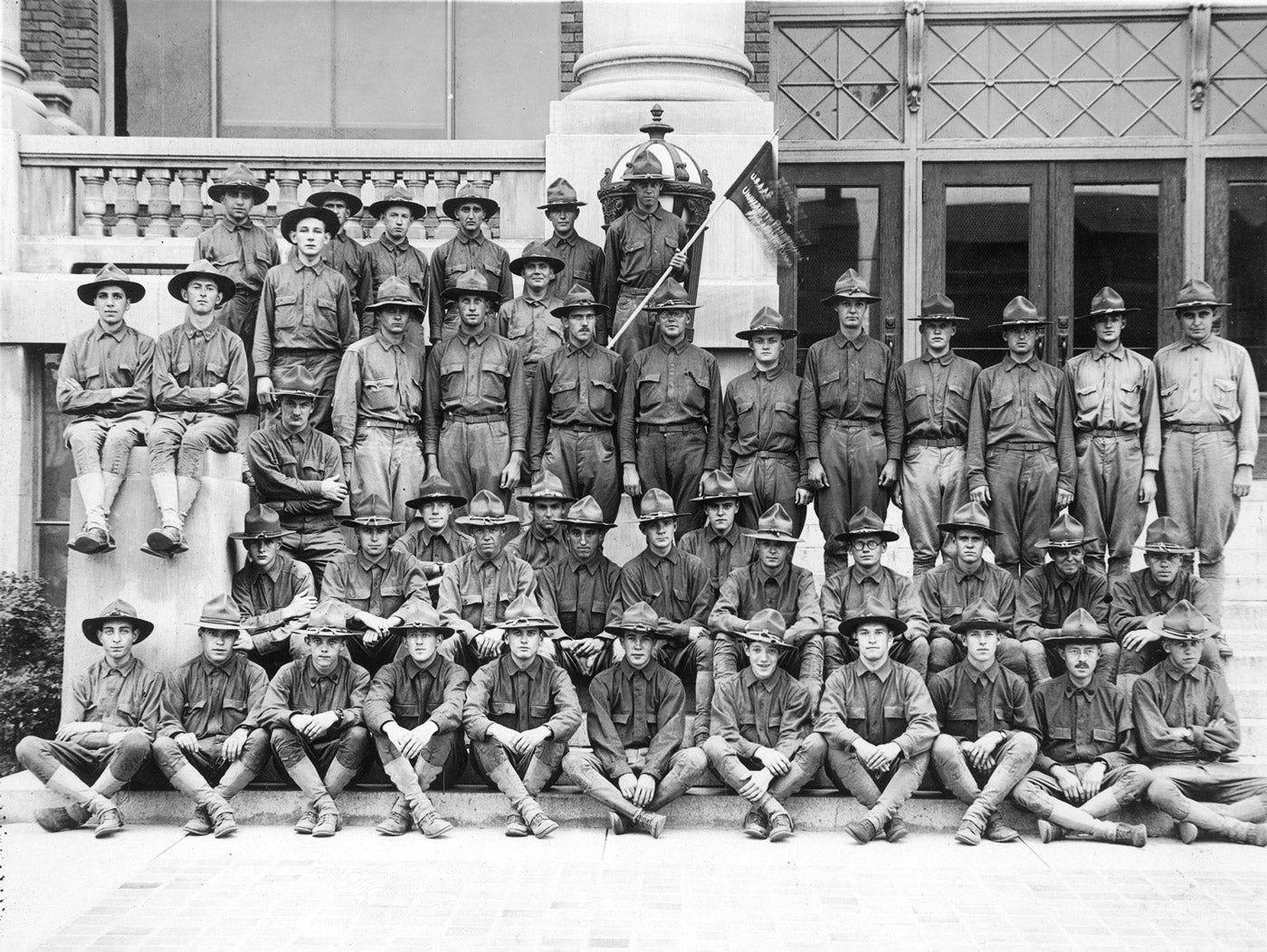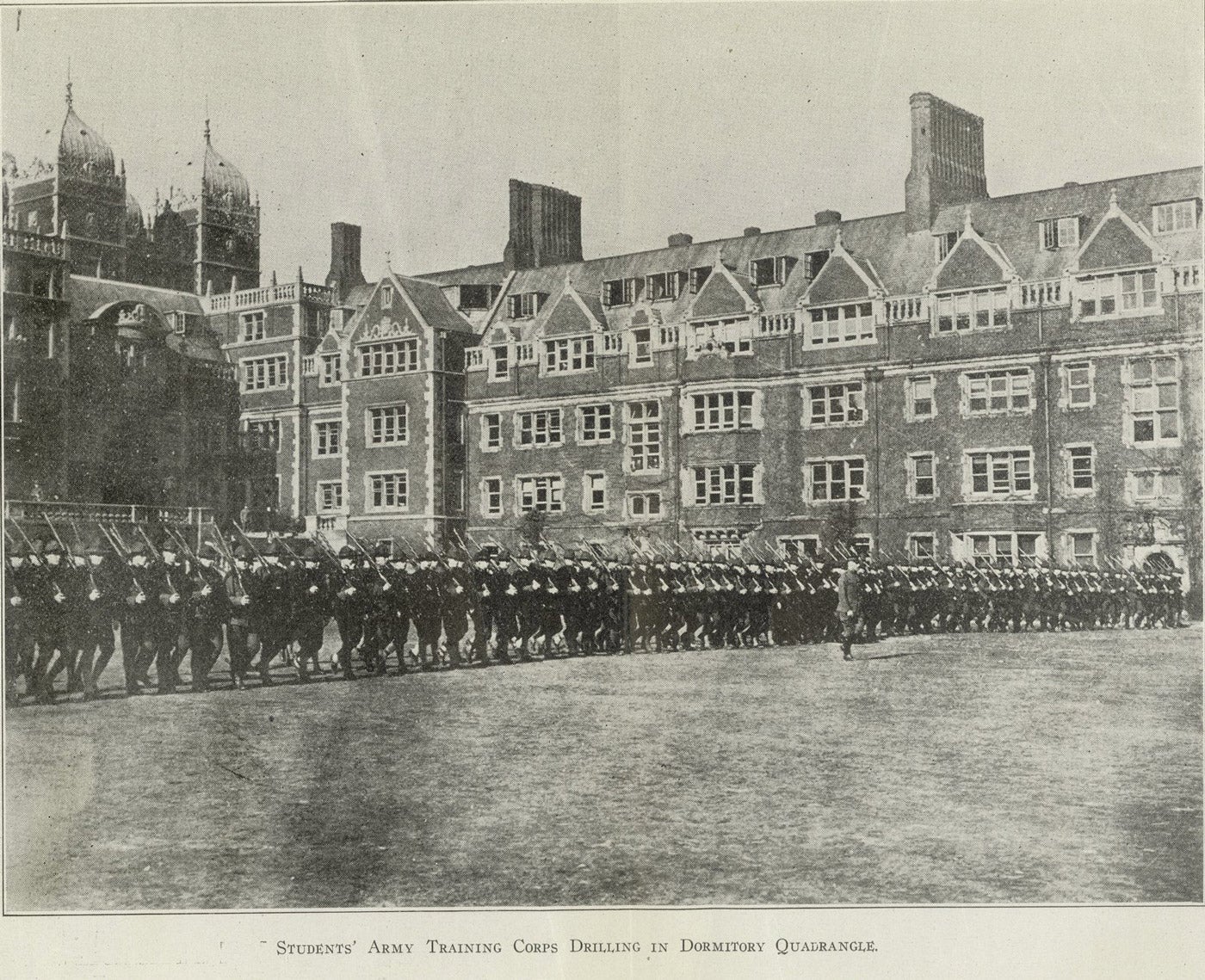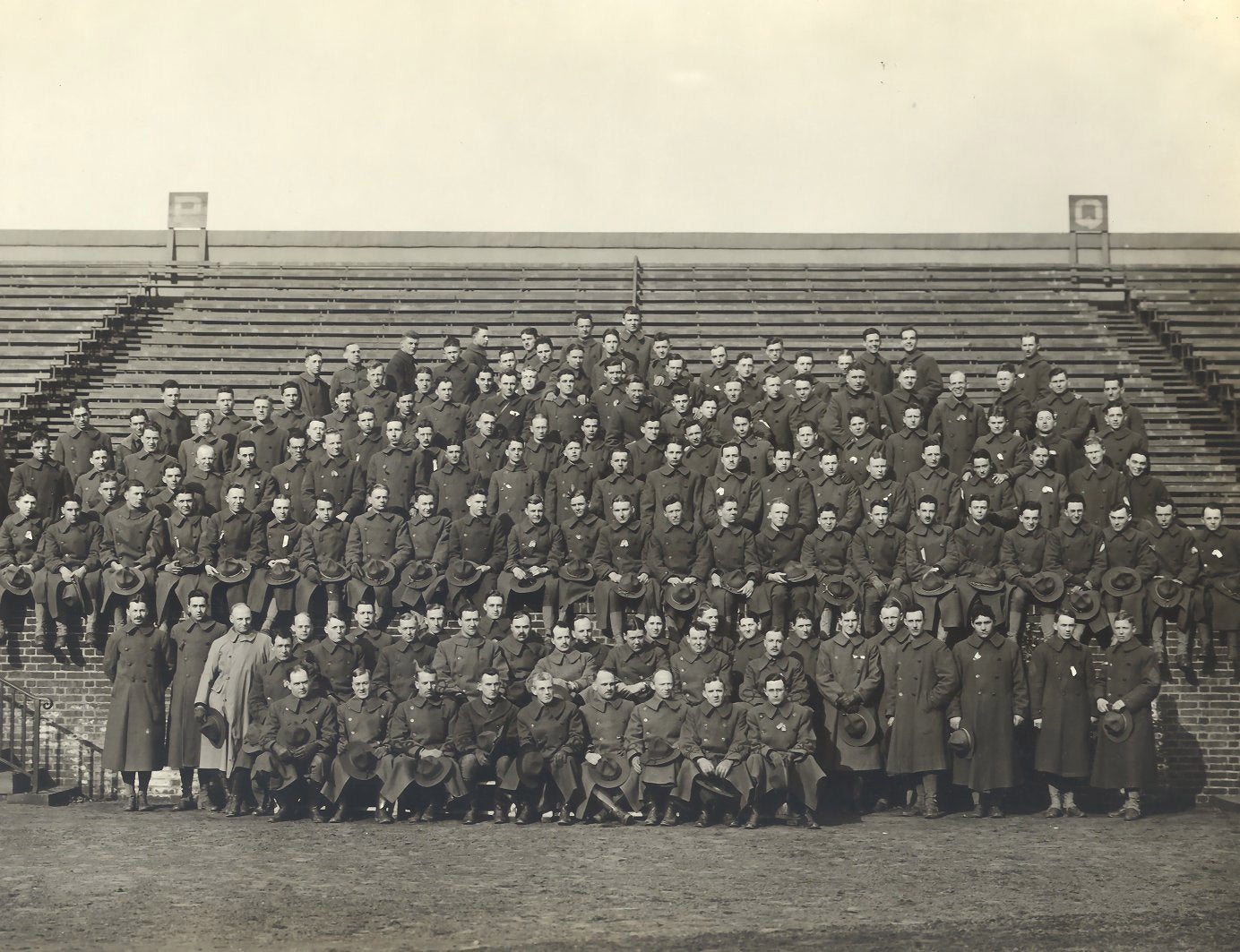Prepared by Rebecca Sokolow, University Archives Summer Research Fellow and an undergraduate at the University of Pennsylvania
August 2013
Introduction
The University Archives and Records Center collections document extensively the activities of Penn’s faculty, students, administrators, and alumni during the World War I period. Administrative documents, University and student publications, and personal papers provide a detailed picture of what the University was like during the Great War. The administrative records primarily reflect the operations of the University and the development of the military training program and curriculum at Penn. University and student publications describe the wartime atmosphere, and document the opinions of faculty, administrators, and students on military training and the war. Personal papers of alumni and faculty further develop the picture of wartime at Penn and in the Philadelphia area. Military service of Penn faculty and students is thoroughly recorded across multiple collections.
This guide has been created to facilitate research on the World War I period. Relevant material has been organized into the following headings: University Administration, Opinion Pieces, Medical Service, Military Training, Personal Papers, Photographs, and Miscellaneous. Entries under each heading contain the name of the collection and the classification, the box and filing folder or folder name where relevant documents can be found, and a short description of the documents’ contents.
Categories
University Administration
General Administration Records, UPA 3
-
Boxes 115-120
Contains records of the University during the World War I period, arranged chronologically, and then by theme alphabetically within each year. Records include an alumni petition to the Provost regarding military instruction, statements by the Provost about the war, correspondence relating to the number of students lost from registration to enlistment, and leaves of absences granted. In addition, this collection includes records of University expenses and property, rosters of enlisted men, and records of University medical service during the war, among other administrative documents.
Board of Trustees Minutes, UPA 1.1
-
Volumes 16 and 17, 1916-1919
The minutes document the decisions made by the trustees about the operation of the University during the World War I period. The war is mentioned explicitly several times. The trustees made important changes to the University because of the war, such as the introduction of military training, the creation of a Department of Military Science and Tactics, and measures taken to attract returning soldiers back to the University after the war. These changes are documented in the Board of Trustees Minutes.
College of Arts and Sciences, Office of the Dean Records, UPB 1.4
-
Box 6
This collection includes applications for leaves of absence for agricultural service and army service, reports from the Curriculum Committee concerning the new wartime curriculum that had to be approved by the War Department of the United States, and lists of faculty members who were of draft age, along with the Draft Board with which they each registered. It also documents communication between the Dean of the College and the War Department’s Committee on Education.
Towne Scientific School Records, UPD 2.1
-
Boxes 1A, FF 1 and FF 2; Box 2
Box 1A contains the Faculty Minutes of the Towne Scientific School from 1915 through 1919. The minutes announce University-wide wartime measures, such as the addition to the faculty of a Professor of Military Science and Tactics. They also discuss Government requests for the Towne School to focus on certain areas that would be helpful to the war effort, such as radio communication. Lastly, some of the minutes are concerned with the Students’ Army Training Corps and its demobilization.
Box 2 contains mainly war-related correspondence and documents of Robert H. Fernald, a professor of the Towne Scientific School.
Office of the Recorder, UPA 9
-
Box 3
These are the files of George Nitzsche, the only person to hold the position of Recorder in the University’s history. Nitzsche documents all the changes that occurred at the University during World War I, and many of the ways in which Penn students, faculty, and administration contributed to the war effort. He also writes in detail about the military training program at the University.
Opinion Pieces
Old Penn/The Pennsylvania Gazette, UPM 8125
-
1914; 1916-1918
Old Penn was an alumni-run weekly magazine that was published under the authorization of the Board of Trustees. In early 1918, it changed its name to The Pennsylvania Gazette. Articles document actions of the University, such as the establishment of the Reserve Officers’ Training Corps at Penn. Issues of the magazine discuss the war service of Penn students and faculty, provide editorials on how to best contribute to the war effort, and give lists of names of Penn students who enlisted in the army during World War I. They also publish articles written by professors of the University, some of which give that professor’s opinion on issues of the war. Old Penn/The Pennsylvania Gazette has many useful photographs printed within its articles from the World War I era.
Red and Blue, UPM 620
-
1917-1919
Red and Blue was a student-run monthly magazine that ran during World War I. Articles discuss the war and military training at the University, as well as the effects of the war on regular University life and activities.
Medical
U.S. Army Base Hospital No. 20 Records, UPC 14
-
Box 1
This collection contains laboratory records, correspondence, minutes of post exchange of Base Hospital No. 20 during World War I.
General Administration Records, UPA 3
-
Box 118, Hospital of the A. E. F. in France, No. 1-3; Box 119, Base Hospital No. 20, No. 1-4, Base Hospital No. 20, Roster of enlisted men
These files document the participation of members of the University in the medical services of the hospital of the American Expeditionary Forces (A. E. F.) in France, as well as Base Hospital No. 20. All of the medical officers and much of the staff of Base Hospital No. 20 came from Penn’s medical school and the University’s hospital, and thus Penn played a large role in running Base Hospital No. 20.
Office of the Recorder, UPA 9
-
Box 3, World War I Clippings, Base Hospital #20 (FF 3), World War I Clippings, General (FF 4), World War I Writings (FF 13), Base Hospital No. 20, by Sergeant George F. Kearney, M.D., N.A.
FF 3 contains clippings from Philadelphia newspapers that discuss Base Hospital No. 20, and Penn’s participation in running that hospital. FF 4 contains more newspaper clippings, some of which include information about the war service of Penn medical officers. FF 13 contains a description of the formation of Base Hospital No. 20, along with lists of those who worked there, written by Sergeant George F. Kearney, a member of the College class of 1917 who was mobilized as part of that hospital.
Military Training
Student Army Training Corps Records, World War I, UPB 72
-
Box 1
This collection includes a list of all the members of the S.A.T.C. at Penn, student grade cards in Architecture, and documentation of the War Issues Course that was required for members of the S.A.T.C. Also included is a final report from the University to The Committee on Education and Special Training S.A.T.C., a scrapbook of government orders and correspondence with the University concerning the University’s role in the care and training of S.A.T.C. members, and documents from the S.A.T.C. commissary.
General Administration Records, UPA 3
-
Box 115, Military Instruction; Box 117, War Service of Penn Students; Box 119, University and the War (World War I)
Box 115 contains a 1915 alumni petition to the Provost regarding the introduction of military training at the University. Boxes 117 and 119 include correspondence about and descriptions of the war work at the University and its effect on registration at the school. They also contain numbers of leaves of absence granted for work in multiple war-related industries.
Board of Trustees Minutes, UPA 1.1
-
Volumes 16 and 17
The minutes document the evolution and development of the University’s military training program during World War I. They begin with the idea of introducing military instruction into the University before the United States joined the war, and follow through to the demobilization of the Students’ Army Training Corps after the armistice was signed, and to the decision to reestablish the R.O.T.C. at Penn. The Board minutes also discuss coursework to go along with military training, and the effects of enlistments on registration and the budget of the University.
University of Pennsylvania Catalogues
-
1917-1918, Department of Military Science and Tactics
The Catalogue provides a brief history and a statement of purpose of the Department of Military Science and Tactics and the military training program at Penn. It also provides a list of the curriculum taught by the Department of Military Science and Tactics.
R. Tait McKenzie Papers, UPT 50 McK37
-
Boxes 7, 8, and 16
R. Tait McKenzie was the director of the Physical Education program at the University during the World War I period. His personal papers include articles he wrote about the need for athletic and physical training within a military training program, and a list of military-related topics on which he lectured at the University. He discusses the physical education work at the University and how it prepared students for enlistment in case of a national emergency. McKenzie’s papers also include a photo album and collection of loose photos focused on military training and rehabilitation of wounded soldiers.
Old Penn/The Pennsylvania Gazette, UPM 8125
-
1914; 1917-1918
This publication has articles that explain in detail how the military training program at Penn worked and was changing and developing. It also documents the people involved in establishing and running the military training program. Many articles commend the patriotic service of members of the Penn community, and several issues publish lists of Penn men who enlisted. Other articles published in the magazine but written by professors give personal opinions on military training. Several photographs of military training at the University are included in issues of the magazine.
Red and Blue, UPM 620
-
1917-1919
This publication provides student opinion on military training at the University.
Personal Papers
Clark and Madeira Family Papers, UPT 50 C592
-
Box 6, FF 21 and FF 22
This collection includes Edith Madeira’s (1865-c.1930) letters describing her service with the Red Cross in Palestine during World War I.
Robert Dechert Family Papers, UPT 50 D293
-
Box 2
The Dechert Family Papers document the military service of Robert Dechert during World War I. They include correspondence, notebooks, newspaper clippings, pamphlets, and personal items. There are also three oversized maps of France from the World War I period.
Michail M. Dorizas Papers, UPT 50 D699
-
Box 1
Dorizas’ papers contain correspondence relating to military service during World War I, and some newspaper clippings about the war.
Frazer Family Papers, UPT 50 F848
-
Box 24, FF 4
John Frazer served in the Intercollegiate Intelligence Bureau during World War I, and also took a year off from being the Dean of the Towne Scientific School to contribute to the war effort during World War I. His papers document his involvement with the First City Troop of Philadelphia before the United States joined the war.
John Rissel Kessler Papers, UPT 50 K425
-
John Rissler Kessler was a graduate of the University of Pennsylvania, who served in the U.S. Army Ambulance Service during World War I. The John Rissler Kessler Papers consist primarily of correspondence from Rissler to his family between 1917 and 1920 – documenting his experience serving as an U.S. Army ambulance driver assigned to the French Army.
R. Tait McKenzie Papers, UPT 50 McK37
-
Boxes 7, 8, and 16
R. Tait McKenzie was the director of the Physical Education program at the University during the World War I period. His personal papers include articles he wrote about the need for athletic and physical training within a military training program, and a list of military-related topics on which he lectured at the University. He discusses the physical education work at the University and how it prepared students for enlistment in case of a national emergency. McKenzie’s papers also include a photo album and collection of loose photos focused on military training and rehabilitation of wounded soldiers.
Percy C. Madeira, Jr. Papers, UPT 50 M181.1
-
Box 1, FF 8
Percy Madeira joined the First City Troop, and saw service in the Mexican Expedition. He then accepted a commission in the Reserve Officers’ Training Corps during World War I. A scrapbook in this collection documents his military service from 1917-1918.
George Wharton Pepper Papers, UPT 50 P423
-
Box 1, FF 28-34; Box 2, FF 10-13; Box 5, FF 50, 53, 54, 58, 60-66, 71, 74; Box 6, FF 2, 4, 7, 9-13, 16-21, 25-28, 31-33, 37, 38, 40, 41, 44, 45, 47-49; Box 7, FF 5, 7-9, 14, 20; Box 17, FF 1-5; Box 20, FF 18, 19; Box 22, FF 12-18; Box 25, FF 28
This collection includes correspondence, speeches, writings, and biographical manuscripts of George Wharton Pepper. Pepper’s opinions on local, national, and international affairs were frequent topics of his correspondence. World War I, the National Preparedness movement and the League of Nations were frequent topics of his speeches.
Alfred Newton Richards Papers, UPT 50 R514
-
Box 28, FF 15-45
Alfred Newton Richards served as the Chair of Pharmacology at the University of Pennsylvania. During World War I he went to Britain to study wound shock with Henry H. Dale and the staff of the British Medical Research Committee. In 1918 he was sent to France by the U.S. Sanitary Corps to set up a laboratory for the effects of gas warfare. This collection contains correspondence concerning World War I, studies on gas warfare, as well as charts, graphs, and other reports having to do with his experiments during the war. It also includes reports from the Special Committee on Surgical Shock, which met during the war.
David Ralston Stief Diary, UPT 50 S925
-
Stief’s diary is an account of his service during World War I. Stief did not have much combat experience, so his diary mostly describes his everyday life in England and France, as well as the leisure activities of hospital workers in France. The diary includes caricatures and photographs.
Townsend Family Papers, UPT 50 T752
-
Box 1, Scrapbook No. 3
This Townsend scrapbook contains World War I memorabilia. It also includes newspaper clippings that provide national and local perspectives on the war. The scrapbook documents the Townsend family’s participation in World War I, as well as John W. Townsend’s family’s efforts to leave Europe when the war broke out during their vacation there.
Photographs
University Photograph Collection, UPX 12
-
Groups and Events Series
The University Photograph Collection includes various photos from the University during the World War I era.
William Gilmore Leaman, Jr. Photograph Album, UPX 12 L436
-
Leaman served on the staff of Base Hospital No. 20 during World War I, and his photo album contains photos of several people and activities of Base Hospital No. 20.
Miscellaneous
Office of Alumni Records Faculty Records, UPF 1.9AR
-
Box 3A
These records are index cards that denote the service records of alumni who served in World War I.
Phi Kappa Sigma Fraternity. Alpha Chapter Alumni Chapter Records, UPS 41PKS
-
Box 1
The chapter records document the fraternity’s involvement in World War I.








